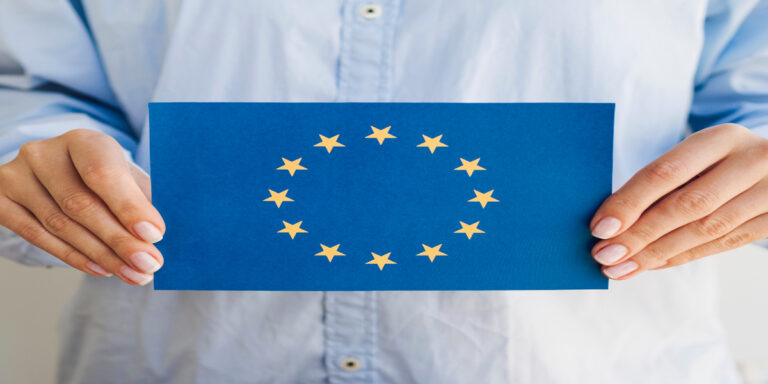Understanding the European Accessibility Act is crucial for businesses aiming to comply with EU accessibility standards. This comprehensive guide covers everything you need to know about the EAA and its implications for your organization.
Europe is widely recognized as a global leader in technological, economic, and social advancements. Yet, many people with disabilities in Europe face barriers in accessing essential day-to-day services. These include healthcare, education, jobs, leisure activities, and political participation. In fact, a survey found that nearly 50% of EU citizens believe that disability-based discrimination is prevalent in their country.
To address this problem, the European Union created several anti-discrimination laws and accessibility standards. One of such is the European Accessibility (EAA), introduced in 2019. In this article, we’ll cover everything you need to know about the EAA and how it may affect your business. Let’s get started.
What is the European Accessibility Act?

The European Accessibility Act (EAA) is a directive which sets common accessibility requirements for products and services in the EU. Its goal is to enable equal access and participation in society for the 101 million adults in the EU with disabilities. Now, why was it necessary to create the EAA? We’ll use an analogy to explain this:
Let’s say you’re walking through a busy market and want to make some purchases. But, you notice that every shop has a different access rule. Some are wide open – anyone can walk in through the doors. Others have a set of steps and narrow doors you can barely squeeze into. And a few require you to pass a security check or cross a physical barrier.
That’s what accessibility regulations in EU member states were like before the EAA came into being. Different countries had different laws for both physical and digital marketplaces. These rules often did not align with each other, creating a patchwork of inconsistent standards across Europe.
This inconsistency did not make access difficult for only people with disabilities. It created challenges for businesses too, especially small and medium-sized enterprises (SMEs). Without harmonized standards, expanding beyond home markets was complex and risky. This was due to the fear of the legal and financial penalties of non-compliance in different jurisdictions.
Objectives and Benefits of the EAA
The EAA aims to create a single set of accessibility regulations across the EU. This would ensure that products and services are accessible to everyone and help people with disabilities live more independent lives. These harmonized standards also remove barriers to the free movement of products and services, promoting a fair market.
What are the economic and social benefits of the EAA?
As a business owner, especially if you run a small or microenterprise, the EAA makes running your business easier. Dealing with different national standards for each market is costly and time-consuming. Harmonized standards means smoother cross-border trade and more mobility. Plus, it allows you to focus more on building innovative products and solutions, rather than meeting regulatory compliance.
For consumers in the EU, the EAA means lower prices and more accessible products. As healthy competition among suppliers increases, prices drop and consumer choice expands, making the overall market more efficient. The EAA also aligns with the EU’s Digital Single Market Strategy, which aims for a connected digital market to ensure accessibility for all.
Scope and Coverage of the EAA
The EAA applies to a wide range of economic operators that provide products and services in the EU single market. These include:
- Manufacturers of products covered by the EAA, such as computers, smartphones, e-book readers, TV equipment, banking services equipment, etc.
- Importers of covered products from non-EU countries.
- Service providers operating in sectors covered by the EAA, such as banking, e-commerce, transport, and digital publishing.
- Online platforms and marketplaces facilitating the sale of covered products from manufacturers/suppliers.
- Public sector bodies at EU, national, regional and local levels when procuring or providing covered products and services.
Essentially, any business or organization selling in the EU market, whether private or public, must comply with the EAA. This specifically applies to those providing the products or services covered by the EAA.
What products and services does the EAA cover?
The European Accessibility Act (EAA) will have a sweeping impact on a variety of commonly used products and services. Here’s what it covers:
- Websites and mobile applications for e-commerce, banking, and other services.
- Desktops and laptops, along with their operating systems and other functionalities.
- ATMs, ticketing machines, check-in machines, and other interactive terminals that provide information but are not part of vehicles or transport equipment.
- Smartphones and tablets used for communications or accessing audiovisual media services.
- E-Readers and other devices specifically designed for reading digital books and periodicals.
However, there are some exclusions. These include:
- Pre-recorded media published before June 28, 2025, and old office file formats.
- Online maps not used for navigational purposes.
- Archived content not updated or edited after June 28, 2025.
- Micro-enterprises with fewer than 10 employees are exempt from some requirements to minimize undue burden.
Accessibility requirements for buildings and emergency services
The EAA grants member states the authority to set accessibility standards for buildings frequented by users of services the EAA covers. This ensures that physical spaces are as accessible as the services offered within them.
The directive also emphasizes the accessibility of emergency communications. It mandates that contact services to the European emergency number ‘112’ adhere to the highest accessibility standards. This ensures that people with disabilities can communicate effectively and receive necessary help during emergencies.
Compliance requirements and timelines
The EAA does not directly specify a single accessibility standard for businesses to follow. Instead, it mandates compliance with “harmonized standards” established by the European Commission. These harmonized standards often refer to, or build upon, existing accessibility guidelines like the EN 301 549 and WCAG 2.1 AA.
Other additional requirements for businesses under the EAA are:
- Accessibility statements: Organizations must publish accessibility statements outlining the efforts taken to ensure compliance with EAA requirements. This helps users understand the accessibility features of a product or service.
- Accessible product packaging and information: Instructions, user manuals, product packaging and other information must also be available in formats accessible to users with disabilities. These include audio versions, Braille lettering, and clear language.
What is the compliance deadline?
EU member states had until June 2022 to adopt the EAA into their national laws. After then, the EAA has a phased implementation timeline with different compliance deadlines based on the product/service category as follows:
- June 28, 2025: For all new products and services released into the EU market after this date.
- June 28, 2030: For all products and services, including those released before June, 28, 2025.
Enforcement and non-compliance penalties
With new regulations like the EAA, there need to be mechanisms in place to ensure businesses actually follow the rules. Here’s how it works:
Compliance checks
Each EU member country will set up its own market surveillance authorities. These bodies will oversee companies to ensure they meet EAA accessibility standards. This could involve activities such as product testing, company audits, and reviewing technical documentations.
Cooperative evaluation
If market surveillance authorities believe your digital product or service does not meet the required accessibility standards, they will conduct a detailed evaluation. As the business under review, you must fully cooperate. This means granting access to your services and quickly responding to inquiries to demonstrate your compliance.
Failing to meet the EAA standards can have serious consequences. Here’s what could happen if your digital services don’t comply:
1. Corrective actions
Initially, if your digital product is found non-compliant, you’ll be asked to make some necessary adjustments. This might involve modifying your website’s design to allow easy navigation with assistive technologies. You may also need to update your mobile app’s interface to make all features accessible.
2. Withdrawal from the market
If you fail to make the required changes within the set timeframe, authorities may escalate the issue. Consequently, they could pull your service from the market. For digital services, this could mean a ban on offering your app or website to users. Such a ban can drastically affect your business operations and revenue.
3. Notification to the Commission
If non-compliance extends beyond local concerns, market surveillance authorities may report the case to the European Commission and other Member States. This increases the scrutiny on your business and the potential for more damage to your brand reputation. .
4. Financial and legal penalties
Each Member State sets its own penalties, but they all align with the need to enforce compliance effectively. The penalties for failing to comply are designed to be “effective, proportionate and dissuasive.” For example, Ireland is set to enforce a landmark non-compliance fine of up to €60,000, a prison term of up to 18 months, or both.
The point is, there will be real “teeth” behind the EAA. EU countries are serious about enforcing it and have set up their systems to identify and punish violators. As such, failure to comply could cost your business a huge fortune.
Preparing for EAA compliance
If you think the EAA compliance deadlines are far off, then think again. They’re actually closer than you imagine, especially if your business needs significant changes. In fact, an European Commission study estimated that around 1 million product models across the EU might need design updates for accessibility. So, what should you do?
First, understand the needs of people with disabilities. Then, incorporate solutions into your product development and service delivery. No matter your company’s size, you need to integrate accessibility throughout the lifecycle of your products and services. This includes research and development, design, testing, and marketing – you name it.
Benefits of meeting EAA standards beyond legal compliance
Although updating for the European Accessibility Act (EAA) is not a small task, being proactive offers benefits. Companies that design with accessibility in mind can access the disability market in the EU. We’re talking about over 101 million people with an annual spending power of nearly €853 billion.
Meeting EAA compliance also opens up significant market opportunities for innovation. The European population is aging, with the number of people over 65 expected to increase by nearly 30% by 2050. By designing products and services to be accessible from the start, businesses can tap into major demographic shifts in Europe and globally.
Many businesses are already taking steps towards this, integrating accessibility into their innovation pipelines. They see it not just as but also as a chance to explore new product ideas, customer segments, and revenue streams. Microsoft exemplifies this approach with their Xbox Adaptive Controller, designed to be accessible for gamers with disabilities.
Closing Thoughts
The European Accessibility Act (EAA) is set to shake up the business world. Whether you run a small startup or a large corporation, this law will influence how you operate, design, and market your products and services. However, as succinctly expressed n the words of famous disability rights activist Judith Heumann,
“Change never happens at the pace we think it should. It happens over years of people joining together, strategizing, sharing, and pulling all the levers they possibly can. Gradually, excruciatingly slowly, things start to happen, and then suddenly, seemingly out of the blue, something will tip.”
Looking ahead, the success of the EAA will depend on training support for companies, and robust enforcement mechanisms. As populations grow older and priorities evolve, the demand for inclusion and accessibility will continue to rise worldwide. As such, companies that embrace this change will be well-positioned for this new era.
Equally AI: Your Partner in Accessibility
For businesses and government agencies in the EU, navigating the EAA can be challenging. We’re here to help make your digital products accessible and compliant. With our expertise in the latest global accessibility standards, we’ll help you meet legal requirements, boost user engagement, and open new market opportunities. Schedule a call with us today!




